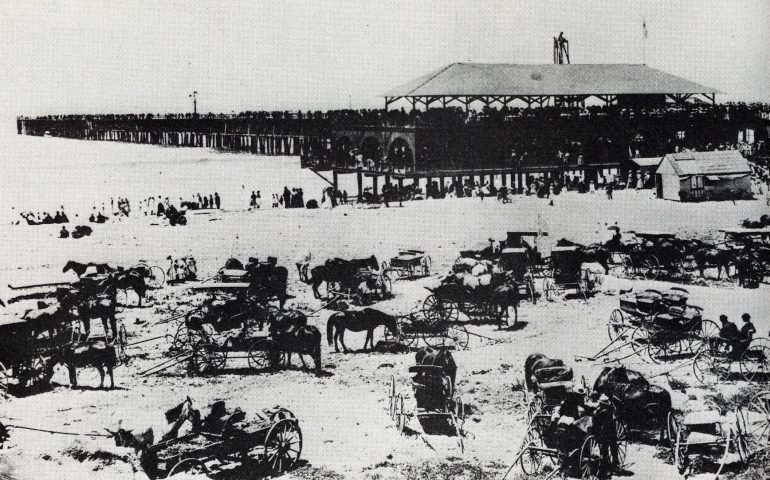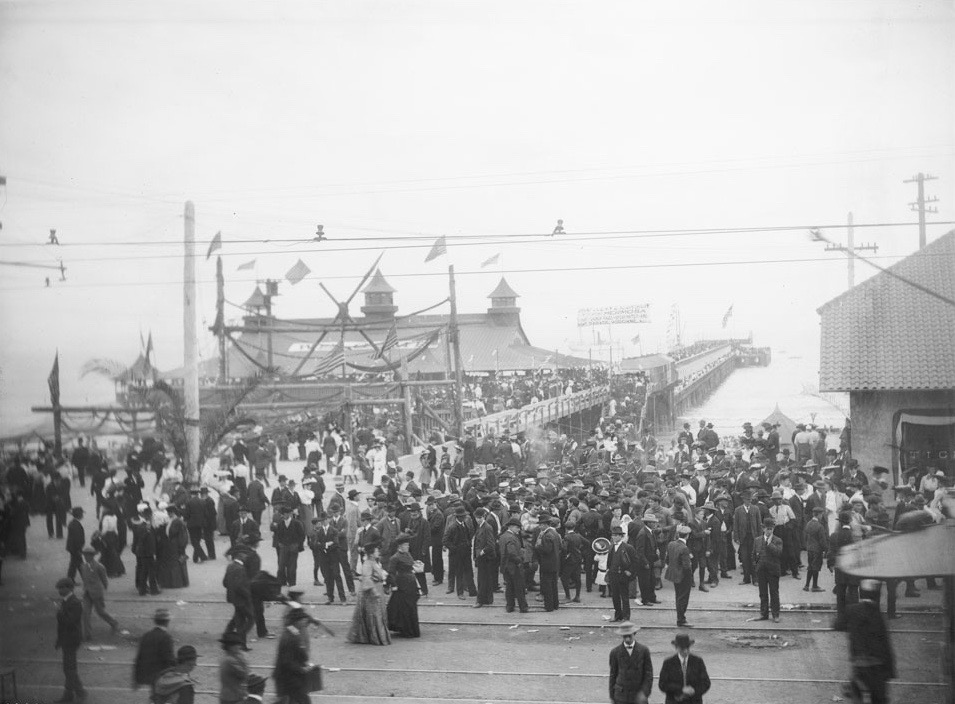—Los Angeles Herald, August 9, 1897
Exciting Encounter With a Shark
Long Beach, Sept.29—A big hammerhead shark was captured near the wharf today after a long and exciting struggle. Judging from its appearance the monster must have had a fight with some denizen of the sea within the past few days, and thereafter laid itself up for temporary repairs. Then it seems to have been hungry, and its greed for food led to its undoing. The shark was first observed this morning on the east side of the wharf. It tried to swallow a bucket of sardines, bucket and all. Then it continued to assume the role of marine goat of the Harlem order, and tried to eat a piece of fish net that was hanging down in the water. These actions attracted attention from the wharf, and various kinds of tempting bait were placed at its disposal. It carried away several fish-hooks and still clamored for more. By way of diversion a hook baited with a sardine was lowered by his shark-ship’s side, and he made a turn for it. The bait was moved so as to keep it out of his reach, and he began spinning almost like a top in his efforts to reach it.
Several attempts to land a spear on the big mark from the wharf failed, and so Percy Hunsaker and John Lavelle tried it with a skiff. Lavelle took the oars and Hunsaker acted as harpooner. The spear was slightly attached to a five-foot pole, and the sixty-foot line was made fast to boat. The other end of the line was fastened in the boat. With some care the boat was rowed near to the shark, and with a strong thrust Hunsaker drove the lance home. It landed near the back of the shark’s head and went right through. The pole came loose, as it was intended to have it do, and there was no chance for the monster to free itself.
The minute the shark felt the iron it was off like a flash, and all efforts to stop it by pulling the other way on the oars were useless. A number of other boats were soon manned and some assistance was rendered by them by driving the game in the desired direction. For nearly an hour the play lasted, the wearisome pulling and hauling being hardly noticed in the excitement of the moment. Human intelligence was finally victorious over brute-instinct and the tired-out game was towed to the wharf with a line about its tail. It measured nine feet six inches.
Sharks of this kind are seldom caught here. They have a head which is very flat, and which widens out into two arms, which project about a foot to each side. The eyes are curiously situated at the outer ends of these arms. The appearance is almost as strange as would be that of a man with his eyes at his shoulders or elbows.
When the shark was pulled out of the water there dropped from it a small scale-less fish, which when placed in a bucket of water, attached itself by suction so firmly to the bottom of the bucket that all efforts to pull it loose were useless.
—Los Angeles Times, September 30, 1898
The good fishing that was prevalent two years ago at this time is “again on” at the wharf, and is the principal drawing attraction at present. Yellowtail, halibut of the larger variety, and sea trout, herring, mackerel, sculpin of the smaller and the smaller varieties have been plentiful.
Of sardines there has been no end, the California Fishing Company’s boat Alpha catching more in three seines than they could take aboard, and there are others.
—Los Angeles Herald, October 10, 1898
Long Beach is coming to the front with the fish stories almost as fascinating as those that came earlier in the season from Catalina and Coronado. Over one hundred yellowtail, halibut and Jewfish were caught one day last week from the Long Beach wharf with throwlines and reel.
—Corona Courier, October 15, 1898
Excellent fishing may now be enjoyed from the wharf, yellowtail, halibut, bonito, rock cod and mackerel biting quite freely.
—Los Angeles Herald, November 21, 1898
A shark which, measured by points on the piling, was between twelve and fifteen feet long, ran up close to shore by the pleasure wharf Friday, but efforts to spear it proved futile,
—Los Angeles Times, January 23, 1900
Mr. Dougall of Riverside has been staying in Long Beach during the past five weeks, and has kept a record of his catches of fish taken with a rod and line from the pleasure wharf. He has caught in that time more than 1500 fish, among the varieties being herring, mackerel, sole, sea trout, sea bass and surf fish.
—Los Angeles Times, July 14, 1900
Wharf Fishing
A new style of fishing along the pleasure wharf has resulted in good catches within the last two or three days. Baited snag hooks are let down to the bottom and allowed to remain there for a while. Lobsters take the bait voraciously, and many of them are jerked up and landed by fishermen who have patience to wait for the lobsters to get fairly planted over the hooks.
A thresher shark created a diversion while in the ocean under the middle of the pleasure pier this morning. Carl D. Hendrickson had a line snapped apart by a ferocious bite of the creature, which is said to have been about six feet long.
—Los Angeles Times, August 21, 1901
Long Beach, May 11.—Heavy swells last night, caused by a high southwest wind, swept away the remaining portion of the old wharf [Magnolia Avenue Pier] at his place, the pilings being strung along the shore for a distance of half a mile. The rough water also broke sixteen or seventeen of the new wharf, but did no special damage.
—Los Angeles Times, May 12, 1900
However, no matter the heavy and diverse use of the Pine Avenue Pier, its days were numbered. It was discovered that the structure of the less-than-ten-year-old pier had been weakened by wood eating teredos (salt water shipworms) and that the pier would need to be completely rebuilt.
In turn, Long Beach, a now popular seaside resort and quickly growing town, would need a new pier.

